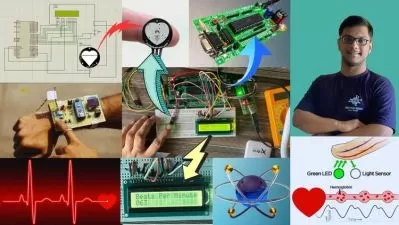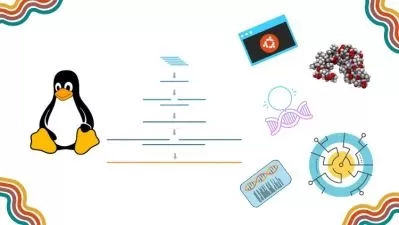Bioinformatics for Everyone Beginner to Expert Guide 2023
Abdul Rehman Ikram
8:45:15
Description
Bioinformatics Beginners to advance course to learn in 10 hours to understand the simple and complex topics of bioinfo
What You'll Learn?
- You will learn about the history and applications of bioinformatics
- You will learn Basic demonstration of Bioinformatics tools
- Different databases used in bioinformatics
- Interpretation of Sequence Alignment
- Tools Used in sequence Alignment in bioinformatics
- Alignment Methods and Representation
- They will be able to use and know different categories of sub-databases of NCBI.
- Plant Genome Databases
- Primary Databases in Bioinformatics
- Secondary Databases in Bioinformatics
- Protein basic Concepts
- Understanding different techniques for protein prediction
- Understanding Comparative or Homology modeling
- Protein Modeling Using GUI Interface
- Swiss Model hands on training
- Protein Modeling Using CLI Interface
- Protein Modeling Using Modeller
- The basics of Next Generation Sequencing and how it can be used for Differential gene expression analysis via RNA sequencing.
- Quality Control of NGS data
- Trimming the Reads of NGS Data
- Different tools for aligning reads to genome
- Differential Expression.
- Ultimately understand how technologies like RNA sequencing could be used to identify specific genes that can cause certain conditions.
- Heatmap Generation of Results
- Interpret the results of DEG's
- Understanding Bioinformatics Pipeline concept
- Use of Galaxy for NGS data processing
Who is this for?
More details
DescriptionUpdated and to-the-point course. It's worth your money and time! This Course runs through segments of bioinformatics topics that you need to learn from the beginner stage to master the bioinformatics field.
The Bioinformatics course is designed to provide a comprehensive overview of the field of bioinformatics, covering the key concepts, tools, and techniques used in the analysis and interpretation of biological data.
The course begins with an Introduction to Bioinformatics, where students will learn about the history and development of the field and the role of bioinformatics in modern biology research. They will also explore the various applications of bioinformatics in areas such as genomics, transcriptomics, proteomics, and metabolomics.
The course will then delve into the topic of Biological Databases, providing an overview of the different types of databases available, and how they are used to store and manage biological data. Students will learn how to navigate and search different databases, including NCBI, Ensembl, and UniProt.
File Formats in Bioinformatics will be covered in the next section, where students will learn about the various file formats used in bioinformatics, such as FASTA, FASTQ, SAM/BAM, and VCF. They will also explore tools and techniques for working with these file formats, including conversion, manipulation, and parsing.
Sequence Alignment and Tools will be covered in the next section, where students will learn about the principles of sequence alignment, and the different tools and algorithms used for sequence alignments, such as BLAST, ClustalW, and MUSCLE. They will also learn how to interpret and analyze the results of sequence alignment.
Command Line Bioinformatics will be covered in the next section, where students will learn how to work with bioinformatics tools and software using the command line interface (CLI). They will explore basic UNIX commands, and learn how to navigate directories, create and edit files, and run bioinformatics tools from the command line.
Bioinformatics and Genomics on GUI and CLI will be covered in the next section, where students will learn how to work with bioinformatics tools and software using graphical user interfaces (GUIs), as well as the command line interface (CLI). They will explore popular GUI-based bioinformatics tools, such as Geneious and CLC Bio, as well as CLI-based tools such as BWA and GATK.
The course will conclude with Bioinformatics and Proteomics, where students will learn about the principles of proteomics, and the different tools and techniques used for protein identification, quantification, and analysis. They will also explore how bioinformatics is used to predict protein structure and function, and design drugs and therapies based on protein interactions.
Who this course is for:
- People generally interested in new research methodologies and would like to try them themselves!
- Beginner Bioinformaticians looking to understand the process of Proteins
- Beginner Bioinformatics Students
- People interested in researching the effects of different pathologies on gene expression or even how gene expression changes over the course of a cell's growth curve.
- People looking to carry out differential gene expression and gene ontology analysis.
- People who want to carry out bioinformatic analysis without the need for complex code.
- Researchers are Encouraged to take this Course.
- Beginners Bioinformatics Students
- Industry Professionals wants to learn Bioinformatics.
Updated and to-the-point course. It's worth your money and time! This Course runs through segments of bioinformatics topics that you need to learn from the beginner stage to master the bioinformatics field.
The Bioinformatics course is designed to provide a comprehensive overview of the field of bioinformatics, covering the key concepts, tools, and techniques used in the analysis and interpretation of biological data.
The course begins with an Introduction to Bioinformatics, where students will learn about the history and development of the field and the role of bioinformatics in modern biology research. They will also explore the various applications of bioinformatics in areas such as genomics, transcriptomics, proteomics, and metabolomics.
The course will then delve into the topic of Biological Databases, providing an overview of the different types of databases available, and how they are used to store and manage biological data. Students will learn how to navigate and search different databases, including NCBI, Ensembl, and UniProt.
File Formats in Bioinformatics will be covered in the next section, where students will learn about the various file formats used in bioinformatics, such as FASTA, FASTQ, SAM/BAM, and VCF. They will also explore tools and techniques for working with these file formats, including conversion, manipulation, and parsing.
Sequence Alignment and Tools will be covered in the next section, where students will learn about the principles of sequence alignment, and the different tools and algorithms used for sequence alignments, such as BLAST, ClustalW, and MUSCLE. They will also learn how to interpret and analyze the results of sequence alignment.
Command Line Bioinformatics will be covered in the next section, where students will learn how to work with bioinformatics tools and software using the command line interface (CLI). They will explore basic UNIX commands, and learn how to navigate directories, create and edit files, and run bioinformatics tools from the command line.
Bioinformatics and Genomics on GUI and CLI will be covered in the next section, where students will learn how to work with bioinformatics tools and software using graphical user interfaces (GUIs), as well as the command line interface (CLI). They will explore popular GUI-based bioinformatics tools, such as Geneious and CLC Bio, as well as CLI-based tools such as BWA and GATK.
The course will conclude with Bioinformatics and Proteomics, where students will learn about the principles of proteomics, and the different tools and techniques used for protein identification, quantification, and analysis. They will also explore how bioinformatics is used to predict protein structure and function, and design drugs and therapies based on protein interactions.
Who this course is for:
- People generally interested in new research methodologies and would like to try them themselves!
- Beginner Bioinformaticians looking to understand the process of Proteins
- Beginner Bioinformatics Students
- People interested in researching the effects of different pathologies on gene expression or even how gene expression changes over the course of a cell's growth curve.
- People looking to carry out differential gene expression and gene ontology analysis.
- People who want to carry out bioinformatic analysis without the need for complex code.
- Researchers are Encouraged to take this Course.
- Beginners Bioinformatics Students
- Industry Professionals wants to learn Bioinformatics.
User Reviews
Rating
Abdul Rehman Ikram
Instructor's Courses
Udemy
View courses Udemy- language english
- Training sessions 106
- duration 8:45:15
- Release Date 2023/03/29










